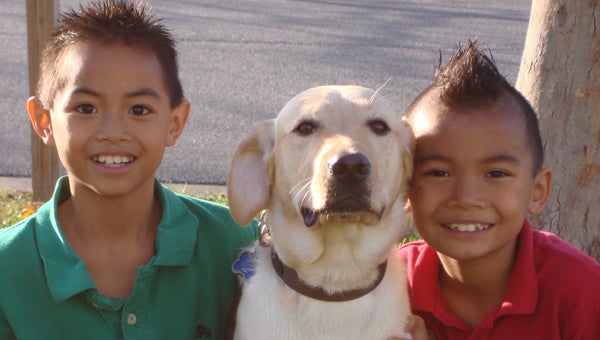Guiding eyes
Published 5:14 pm Thursday, January 24, 2013

Eugene and Richard Martin embrace one of the dogs their family raised for Guiding Eyes for the Blind.
Local family raises dogs to help the blind
The Martin family readily admits that Garvey changed their lives, but Garvey may have changed Lora Ann Niino’s life much more.
Garvey was an 11-week-old puppy in 2010 when he came to live with the Martins in Suffolk. After the Martins raised him for more than a year, he was formally trained as a guide dog and paired with Niino, a clinical psychologist who lost her vision in a car accident.
“It’s kind of like sending your kids off to college,” said Kristin Martin. “Yeah, we’re sad to see you go, but wow, what will you become.”
Martin, her husband Christopher and sons Eugene, 11, and Richard 9, are currently raising their third puppy with Guiding Eyes for the Blind, which relies on volunteer puppy-raisers to care for the dogs until they are ready for formal guide-dog training by professionals.
The Martins got into the organization shortly after Jackie, their chocolate lab, died.
“We wanted to get another dog, but we also wanted to teach our kids some responsibility and to give back to the community,” Martin said. She stumbled across an article about Guiding Eyes for the Blind “and thought, ‘What a great fit,’” she said.
Before getting their first puppy, the Martins attended class one hour each week for four weeks, learning about the organization and their responsibility.
After getting Garvey, they attended with the dog one hour a week for the first three months, with less frequent classes thereafter.
“We had never trained a dog before this,” Martin said. “They teach you everything you need to know.”
Puppy-raisers are responsible for food and toys, although the organization pays for veterinary care. The volunteers also are expected to teach basic obedience skills and manners, and they introduce the pups to all aspects of life so they are familiar with and comfortable in any circumstance.
“We just kind of show them the world,” Martin said. “It’s that constant reintroducing them to things so they become comfortable and confident.”
Not all dogs are suited to be guide dogs for blind people.
Some dogs — for example, those too easily distracted by smell — might go on to work in public safety, as did the Martins’ second puppy, Sean, who now works for the Connecticut State Department of Corrections. Dogs with a strong sense of smell make excellent public safety officers because of their ability to detect bomb-making materials or drugs, or track a person’s scent.
“Even though they’re not going to be a guide dog, they can still be something incredibly helpful for society,” said Michelle Brier, director of marketing and communications for Guiding Eyes for the Blind.
Four years ago, Guiding Eyes for the Blind launched Heeling Autism, which trains service dogs to provide safety and companionship for children on the autism spectrum.
For blind people who are partnered with one of the dogs, it is life-changing, Brier said.
“Some people have said it’s like getting out of prison,” she said, contrasting a guide dog with the less versatile white cane. “A lot of people find the cane to be isolating.”
Not only does a dog help its partner make friends, Brier said, it can do things the cane can’t do — for instance, indicate if there’s a car coming or steer the human around low-hanging overhead objects.
“Guide dogs really extend people’s horizons tenfold,” Brier said.
For the puppy-raisers, who are invited to their dog’s graduation ceremony and get to meet the human he’s paired with, it is a rewarding experience, Martin said.
“It’s amazing to watch the growth of these dogs,” she said. “It all comes full circle and you don’t miss them anymore. You’re really proud you were a part of something so amazing.”
The New York-based Guiding Eyes for the Blind program is always looking for volunteer puppy-raisers.
“We literally wouldn’t be able to do what we do without our volunteers,” Brier said. The organization currently has about 400 volunteers from Maine to North Carolina, to be within range of its headquarters, but it matches dogs with clients across the country and in several other countries.
Volunteers can be families, couples or single people, old or young, living in urban, suburban or rural areas, in an apartment, townhouse or single-family residence, according to Guiding Eyes for the Blind.
Donations are also needed constantly for the program, which is funded completely by private donors.
For more information, visit www.guidingeyes.org.






